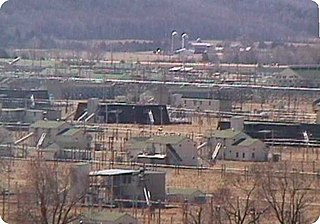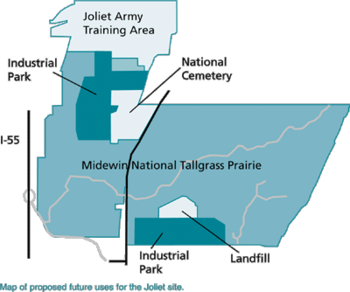
Elwood is a village in Will County, Illinois, United States. The population was 2,279 at the 2010 United States Census.

The tallgrass prairie is an ecosystem native to central North America. Historically, natural and anthropogenic fire, as well as grazing by large mammals provided periodic disturbances to these ecosystems, limiting the encroachment of trees, recycling soil nutrients, and facilitating seed dispersal and germination. Prior to widespread use of the steel plow, which enabled large scale conversion to agricultural land use, tallgrass prairies extended throughout the American Midwest and smaller portions of southern central Canada, from the transitional ecotones out of eastern North American forests, west to a climatic threshold based on precipitation and soils, to the southern reaches of the Flint Hills in Oklahoma, to a transition into forest in Manitoba.
The Alabama Army Ammunition Plant (ALAAP), was a United States munitions plant built and operated during World War II. The facility is located four miles (6 km) north of Childersburg, Alabama in Talladega County, Alabama.

The Midewin National Tallgrass Prairie (MNTP) is a tallgrass prairie reserve and similarly preserved as United States National Grassland operated by the United States Forest Service. The first national tallgrass prairie ever designated in the U.S. and the largest conservation site in the Chicago Wilderness region, it is located on the site of the former Joliet Army Ammunition Plant between the towns of Elwood, Manhattan and Wilmington in northeastern Illinois. Since 2015, it has hosted a conservation herd of American bison to study their interaction with prairie restoration and conservation.
The Picatinny Arsenal is an American military research and manufacturing facility located on 6,400 acres (26 km2) of land in Jefferson and Rockaway Township in Morris County, New Jersey, United States, encompassing Picatinny Lake and Lake Denmark. The Arsenal is the headquarters of the US Army Combat Capabilities Development Command Armaments Center. It is known for developing the ubiquitous Picatinny rail, as well as being the Army's center of expertise for small arms cartridge ammunition.

James A. Garfield Joint Military Training Center is an Ohio Army National Guard military base in the U.S. state of Ohio located between Ravenna and Newton Falls and adjacent to the village of Windham. It was previously known as Camp Ravenna Joint Military Training Center, the Ravenna Training and Logistics Site, and the Ravenna Army Ammunition Plant (RVAAP) and commonly known as the Ravenna Arsenal. Before its present status as a training facility for the Ohio National Guard, Camp James A. Garfield was a military ammunition production facility for the United States Army. As an arsenal, the facility was at peak operation during World War II and would serve as an ammunitions plant in various roles until 1992. Camp James A. Garfield remains an important part of the history and geography of Portage County. The facility occupies portions of Freedom, Windham, Charlestown, and Paris townships in Portage County, along with part of Braceville Township in Trumbull County.

Prairie restoration is a conservation effort to restore prairie lands that were destroyed due to industrial, agricultural, commercial, or residential development. For example, the U.S. state of Illinois alone once held over 35,000 square miles (91,000 km2) of prairie land and now just 3 square miles (7.8 km2) of that original prairie land is left.

Weldon Spring Ordnance Works (WSOW) was a 17,323-acre (70.10 km2) U.S. Government-owned, contractor-operated (GOCO) facility in St. Charles County, Missouri, 55 km west of St. Louis. The site was originally operated by the Atlas Powder Company during World War II from 1941 to 1945 to produce explosives. The Atomic Energy Commission acquired part of the property in 1955, and Mallinckrodt, Inc. processed uranium ore from 1957 to 1966 under contract. The site has been divided into several parcels, and ownership has transferred over the years. Two portions of the original WSOW property are now Superfund sites that require substantial cleanup efforts. The environmental remediation of the WSOW site is currently designated as a major project of the Defense Environmental Restoration Program of the United States Department of Defense. Part of the original property is still used by the Army Reserve as the Weldon Spring Training Area.

The Indiana Army Ammunition Plant was an Army manufacturing plant built in 1941 between Charlestown and Jeffersonville, Indiana. It consisted of three areas within two separate but attached manufacturing plants:

The Badger Army Ammunition Plant or Badger Ordnance Works (B.O.W.) is an excess, non-BRAC, United States Army facility located near Sauk City, Wisconsin. It manufactured nitrocellulose-based propellants during World War II, the Korean War, and the Vietnam War. It was a large munitions factory during World War II. As of 2013, the facility was in the end stages of demolition and remediation in preparation for property transfer.

West Virginia Ordnance Works (WVOW) was a United States Army ammunition manufacturing facility constructed and operated during World War II. It was located north of Point Pleasant, West Virginia in Mason County encompassing 8,323 acres (33.68 km2). The $45 million plant employed 3500 at its peak and operated from 1942 to 1945. The site was disposed of following the war and land was utilized by creating a landfill, the McClintic Wildlife Management Area, the Mason County Airport and an industrial park among others.
Holston Army Ammunition Plant (HSAAP) manufactures Research Department Explosive (RDX) and High Melting Explosive (HMX) for ammunition production and development. It is government-owned and contractor-operated (GOCO) facility that is part of the US Army Joint Munitions Command.

Lake City Army Ammunition Plant (LCAAP) is a 3,935-acre (15.92 km2) U.S. government-owned, contractor-operated facility in northeastern Independence, Missouri, that was established by Remington Arms in 1941 to manufacture and test small caliber ammunition for the U.S. Army. The facility has remained in continuous operation except for one 5-year period following World War II. As of July 2007, the plant produced nearly 1.4 billion rounds of ammunition per year. In addition, Lake City performs small caliber ammunition stockpile reliability testing and has ammunition and weapon testing responsibilities as the NATO National and Regional Test Center. LCAAP is the single largest producer of small arms ammunition for the United States Armed Forces.
Milan Army Ammunition Plant (MLAAP) was an ammunition plant of the United States Army Joint Munitions Command near Milan, Tennessee and about 23 miles (37 km) north of Jackson, Tennessee.
Radford Army Ammunition Plant (RFAAP) is an ammunition manufacturing complex for the U.S. military with facilities located in Pulaski and Montgomery Counties, Virginia. The primary mission of the RFAAP is to manufacture propellants and explosives in support of field artillery, air defense, tank, missile, aircraft, and naval weapons systems. As of 2011 RFAAP is operated by BAE Systems under contract to the US Army Joint Munitions Command. The current Commander for the Radford Army Ammunition Plant (RAAP) is LTC Russell A. Jones.

The Twin Cities Army Ammunition Plant was a United States Army ammunition plant located in Ramsey County, Minnesota in the current boundaries of the suburbs of Arden Hills and New Brighton, bounded by County Road I to the north, I-35W to the west, U.S. Route 10 to the southwest, County Highway 96 to the south, and Lexington Avenue to the east. The site had 255 buildings across 2,382 acres (9.64 km2). Current land redevelopment involves the removal of these buildings.

The Louisiana Army Ammunition Plant, formerly known as the Louisiana Ordnance Plant or as The Shell Plant, is an inactive 14,974-acre (60.60 km2) plant to load, assemble and pack ammunitions items. During production from 1942 to 1994, the Army disposed of untreated explosives-laden wastewater in on-site lagoons, contaminating soil, sediments and groundwater with hazardous chemicals. It is a government-owned, contractor-operated facility located off U.S. Highway 80 in Webster Parish near Doyline between Minden and Bossier City, Louisiana. Part of LAAP is known as Camp Minden, a training center for the Louisiana Army National Guard. LAAP and Camp Minden have become nearly interchangeable terms, with most references to Camp Minden.
The Nebraska Ordnance Plant is a former United States Army ammunition plant located approximately ½ mile south of Mead, Nebraska and 30 miles west of Omaha, Nebraska in Saunders County. It originally extended across 17,250 acres (69.8 km2) producing weapons from 1942-45 after which the Army used it as a bomb factory during the Vietnam War. Environmental investigations in the 1980's found the soil and groundwater contaminated with the explosive RDX and the degreaser trichloroethylene. In 1990, federal agencies added the site to the National Priorities List as a Superfund site. Remediation included soil excavation and water treatment, the latter of which has been ongoing since 1997. Water is contained and treated at 4 treatment plants and the known plumes are monitored at hundreds of wells. The latest wells, dug deeper into the bedrock than previously, showed RDX and TCE above desired action levels in April 2016.
The Cornhusker Army Ammunition Plant was built by the US army beginning in 1942 to produce munitions during World War II. The plant produced munitions during World War II, the Korean War, and the Vietnam War. It is located 6 miles (10 km) west of Grand Island, Nebraska. It is currently an EPA Superfund site because of groundwater contamination by explosives and soil contamination by explosives and heavy metals. The plant occupies 12,042 acres (4,873 ha).














